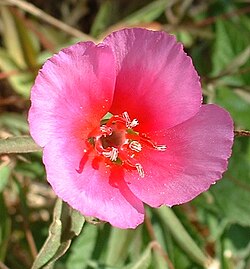| Clarkia | |
|---|---|
 | |
| Clarkia amoena (farewell to spring) | |
| Scientific classification | |
| Kingdom: | Plantae |
| Clade: | Tracheophytes |
| Clade: | Angiosperms |
| Clade: | Eudicots |
| Clade: | Rosids |
| Order: | Myrtales |
| Family: | Onagraceae |
| Subfamily: | Onagroideae |
| Tribe: | Onagreae |
| Genus: | Clarkia Pursh (1813) |
| Type species | |
| Clarkia pulchella | |
| Species | |
over 40, see text | |
| Synonyms [1] | |
| |
Clarkia is a genus within the flowering plant family Onagraceae. Over 40 species are currently classified in Clarkia; almost all are native to western North America, though one species (Clarkia tenella) is native to South America.
Contents
Clarkias are typically annual herbs, growing either prostrate or erect to a height of less than 2 metres. Their leaves are small and simple, from 1 to 10 cm in length depending on the species. Their flowers have four sepals and four petals, usually white, pink, or red, and are often spotted or streaked. Their fruit are elongated, cylindrical pods, usually 4-grooved or 8-grooved, and when mature they hold many tiny, cubical seeds. [2]
Several members of the genus are sometimes referred to by the common name "godetia", including Clarkia amoena, Clarkia affinis , and Clarkia lassenensis (the Lassen godetia). This is because they were formerly classified in a genus called Godetia, which is no longer recognised since its members have been absorbed into the genus Clarkia. Older sources may still use Godetia as a genus name.
The genus was named in honour of the explorer Captain William Clark. Unofficially, the genus is sometimes referred to as Yorkia, in honor of York, an African-American member of the Lewis and Clark Expedition. [3]
The Royal Navy had a warship called HMS Clarkia, a Flower-class corvette.





























